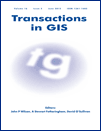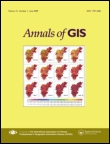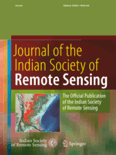
Revue Internationale de Geomatique
Scope & Guideline
Exploring Interdisciplinary Insights in Geomatics
Introduction
Aims and Scopes
- Geospatial Data Analysis and Modeling:
The journal extensively covers research on geospatial data analysis, including the use of Geographic Information Systems (GIS), remote sensing, and machine learning techniques to model and analyze various geographical phenomena. - Environmental Monitoring and Assessment:
A core focus area is the application of geomatics in environmental monitoring, including studies related to land use, pollution, and natural disaster risk assessment, which are essential for sustainable development. - Urban Planning and Development:
The journal addresses urban dynamics and planning through the integration of geomatic techniques, exploring spatial patterns, urban green spaces, and infrastructure development. - Hydrological and Geomorphological Studies:
Research on hydro-morphometric characteristics, water quality, and landform impacts are prominent, reflecting the journal's commitment to understanding water systems and their management. - Cartography and Spatial Representation:
The journal contributes to modern cartographic practices, emphasizing innovative mapping techniques and visual representation of spatial data to enhance understanding and communication.
Trending and Emerging
- Machine Learning and Artificial Intelligence Applications:
There is a growing trend in employing machine learning and AI techniques for geospatial analysis, reflecting the need for advanced data processing capabilities in handling complex geographical datasets. - Climate Change and Environmental Impact Assessments:
Research focusing on climate change effects, such as urban CO2 emissions and disaster risk assessment, has gained traction, underscoring the importance of geomatics in addressing global environmental challenges. - Integration of Remote Sensing with GIS:
The combination of remote sensing data with GIS applications is increasingly prevalent, showcasing innovative approaches to environmental monitoring and resource management. - Dynamic Spatial Analysis:
Emerging studies that utilize spatio-temporal data to understand changing patterns in urban dynamics and environmental factors indicate a shift towards more dynamic and responsive research methodologies. - Geospatial Accessibility Studies:
There is an uptick in research examining geographical accessibility to essential services, such as healthcare, reflecting broader socio-economic concerns and the role of geomatics in enhancing community well-being.
Declining or Waning
- Traditional Cartographic Techniques:
There seems to be a waning interest in traditional cartographic methods, as the focus shifts towards digital and interactive mapping solutions, which are more relevant in contemporary research. - Basic Geometric Applications:
Research centered on fundamental geometric applications in geomatics has diminished, likely due to advancements in more complex modeling techniques and the integration of artificial intelligence. - Static Land Use Studies:
Studies focusing solely on static land use classifications without incorporating dynamic analysis or temporal changes are becoming less frequent, indicating a shift towards more comprehensive, multi-dimensional perspectives.
Similar Journals

International Journal of Applied Earth Observation and Geoinformation
Empowering Research through Earth Observation Excellence.International Journal of Applied Earth Observation and Geoinformation is a premier peer-reviewed journal published by Elsevier, focusing on the integration and application of earth observation and geoinformation technologies across diverse fields. With an open access model established in 2020, this journal enhances accessibility and dissemination of research crucial for addressing global challenges related to climate change, resource management, and sustainable development. The journal occupies a notable position within the academic community, featuring a Q1 ranking in multiple categories including Computers in Earth Sciences, Earth-Surface Processes, and Global and Planetary Change, reflecting its significant impact and relevance in these disciplines. It is recognized for its high-quality articles that explore innovative methodologies and applications, making it an essential resource for researchers, practitioners, and students alike who seek to advance their understanding of earth dynamics and geospatial technology. The journal is indexed in Scopus with impressive rankings that underscore its high citation impact and scholarly influence, with an emphasis on providing a platform for the latest findings in management, monitoring, and policy in environmental science.

Transactions in GIS
Empowering Researchers with Cutting-Edge GIS KnowledgeTransactions in GIS is a premier academic journal published by WILEY, dedicated to advancing the field of Geographic Information Science (GIS). With an ISSN of 1361-1682 and an E-ISSN of 1467-9671, this journal has continually contributed valuable insights since its inception in 1996, transforming the landscape of GIS research and application. Covering a broad scope within Earth and Planetary Sciences, it holds a notable Q2 ranking and stands in the 74th percentile among its peers as per Scopus rankings. The journal serves as a critical platform for researchers, professionals, and students who seek to disseminate and engage with innovative GIS methodologies, applications, and theoretical advancements. With a commitment to quality and rigor, Transactions in GIS remains a vital resource for those at the forefront of geographic research and analysis.

Annals of GIS
Advancing Geographic Insights for a Better TomorrowWelcome to the Annals of GIS, a leading academic journal published by Taylor & Francis Ltd, dedicated to advancing the field of Geographic Information Science and its applications. With an ISSN of 1947-5683 and an E-ISSN of 1947-5691, this Open Access journal has been ensuring wide accessibility since 2019, thereby bolstering the dissemination of knowledge in areas such as remote sensing, spatial analysis, and geoinformatics. Hailing from the United Kingdom, the journal ranks impressively within its categories, achieving a Q2 status in Computer Science Applications and a prestigious Q1 ranking in Earth and Planetary Sciences for 2023, placing it in the top 10% among its peers. With a focus on innovative research spanning from 2009 to 2024, the Annals of GIS serves as a vital platform for researchers, professionals, and students alike, providing insights and fostering discussions that push the boundaries of geographic technologies and their real-world applications.

GEOGRAPHICAL ANALYSIS
Exploring the Depths of Earth-Surface ResearchGEOGRAPHICAL ANALYSIS, published by WILEY, is a premier scholarly journal that has been at the forefront of geographical and earth-surface research since its inception in 1969. With an ISSN of 0016-7363 and an E-ISSN of 1538-4632, this journal has established itself as an essential resource for researchers and professionals in the fields of Earth-Surface Processes and Geography, Planning and Development, achieving impressive rankings of 13th and 60th in their respective categories according to Scopus, placing it in the Q1 quartile for both. The journal is renowned for its rigorous peer-reviewed articles that contribute valuable insights into spatial analysis, environmental impacts, and urban planning, thus fostering a deeper understanding of geographical phenomena. With access options available through traditional subscriptions, GEOGRAPHICAL ANALYSIS continues to serve as a critical platform for the dissemination of cutting-edge research and innovative methodologies, ultimately shaping the future of geographical inquiry and application.

South African Journal of Geomatics
Fostering Collaboration in Geographic Information ExcellenceSouth African Journal of Geomatics is a pivotal platform dedicated to the advancement of geomatics, focusing on the dynamic intersection of geographic information science, surveying, and mapping technologies. Published by CONSAS CONFERENCE, the journal serves as a crucial resource for researchers, professionals, and students in the geomatics field, providing insightful, peer-reviewed articles that explore contemporary challenges and innovations. Operating under an open-access model, the journal ensures the wide dissemination of knowledge, promoting collaboration and scholarly exchange among the global geomatics community. With a commitment to enhancing the visibility of significant research and fostering academic discourse, the South African Journal of Geomatics plays a vital role in contributing to the development of this essential discipline in South Africa and beyond.

Geodetski List
Exploring the Frontiers of Earth and Planetary SciencesGeodetski List is a prestigious journal published by the Croatian Geodetic Society, focusing on the field of geodesy within Earth and Planetary Sciences. Since its inception, the journal has become a vital resource for researchers, professionals, and students who are keen to explore advancements and innovations in geodetic science. With a broad scope encompassing theoretical and applied aspects, Geodetski List provides a platform for disseminating research findings, case studies, and technical developments, facilitating knowledge exchange among geospatial experts. The journal has been indexed from 1979 to 1983, 1985, and from 2008 to 2024, maintaining a respectable standing within the academic community, as evidenced by its classification in the Q3 quartile for 2023. Although not open access, the journal represents an invaluable asset for its audience, aiding in the understanding of geodetic practices, methodologies, and technological advancements. Located in Zagreb, Croatia, it is dedicated to promoting robust scholarship in geodesy and its applications.

ISPRS International Journal of Geo-Information
Connecting insights, shaping the future of geoinformation.ISPRS International Journal of Geo-Information, published by MDPI, stands at the forefront of the field of geospatial sciences, contributing valuable knowledge and research insights since its inception in 2012. This open access journal, which boasts an impressive collection of articles that emphasize the integration of geographic information systems (GIS) in Earth and planetary sciences, currently achieves a remarkable standing, with a 2023 impact factor ranking in the Q1 category for both Earth and Planetary Sciences and Geography, Planning and Development. Researchers and professionals engaged in the study of spatial data, remote sensing, and innovative geoinformation technologies will find the journal an essential resource, offering diverse perspectives and methodologies. With its open access model, the journal aims to promote the dissemination of knowledge globally, fostering collaboration among scholars while pushing the boundaries of research in geoinformation disciplines. The journal is based in Switzerland and is well-positioned to contribute significantly to the understanding and application of geospatial data for societal advancements.

Journal of the Indian Society of Remote Sensing
Connecting Scholars to the Frontiers of Remote SensingJournal of the Indian Society of Remote Sensing, published by SPRINGER, stands as a prominent contribution to the fields of Earth and Planetary Sciences and Geography, Planning and Development. With an ISSN of 0255-660X and an E-ISSN of 0974-3006, this esteemed journal has been in circulation since 1973, showcasing a rich repository of research and advancements in remote sensing applications, methodologies, and technologies, specifically within the Indian context and beyond. The journal's impact is underscored by its placement in the Q2 category of both Earth and Planetary Sciences and Geography as of 2023, ranking impressively in the Scopus database with significant percentiles. With the intent to bridge the gap between theory and practical application, it invites scholars, researchers, and professionals to contribute innovative studies that enhance our understanding of remote sensing and its implications in various domains. The Journal of the Indian Society of Remote Sensing is a vital resource for anyone looking to remain at the forefront of research in this dynamic field.

EARTH
Championing open access for global scientific dialogue.EARTH is a prestigious journal published by MDPI, located in Switzerland, with a commitment to advancing the fields of Earth and Planetary Sciences and Environmental Science. Launched in 2020, the journal emphasizes an open-access publication model, ensuring that high-quality research is widely accessible to the scientific community and beyond. As of 2023, it proudly holds a Q2 ranking in both the Environmental Science and Earth and Planetary Sciences categories, indicating its significant impact within these disciplines; it ranks #90 out of 219 and #70 out of 159 in their respective fields according to Scopus. With the convergence of multidisciplinary research and the critical challenges our planet faces, EARTH seeks to publish innovative studies that foster a deeper understanding of geological and environmental processes. Researchers, professionals, and students alike will find this journal an invaluable resource for the latest findings and discussions shaping our understanding of Earth sciences.

Boletim de Ciencias Geodesicas
Pioneering Discoveries in the Dynamic World of GeodesyBoletim de Ciências Geodésicas is an esteemed academic journal published by the Universidade Federal do Paraná within its Centro Politécnico. Focused on the dynamic field of Earth and Planetary Sciences, this Open Access journal has been a pivotal resource since 1997, fostering the dissemination of critical research and innovative methodologies. With an impact factor indicative of its relevance in the discipline, Boletim de Ciências Geodésicas ranks in the Q3 quartile for Earth and Planetary Sciences as of 2023, showcasing its commitment to quality scholarship in a competitive field. Researchers and students alike will benefit from access to cutting-edge findings, given its broad scope that encompasses various aspects of geodesy and related sciences. The journal's convergence of research from 2005 to 2024 ensures that it remains at the forefront of emerging trends and fundamental developments in the discipline, further enhancing its esteemed reputation in the academic community.